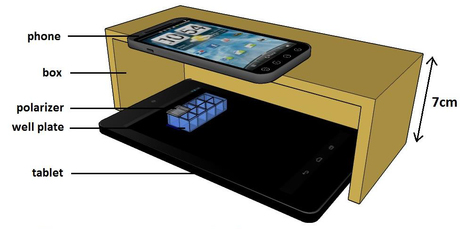Smartphones converted into biosensors

Researchers from the ARC Centre for Nanoscale BioPhotonics (CNBP) have reconfigured smartphones as bioanalytical devices that allow for immediate diagnostic testing of arthritis, cystic fibrosis, acute pancreatitis and other clinical diseases. They have also developed an app to bring diagnostic capabilities to anyone with a smartphone.
Writing in the journal Sensors, the team explained that their bioanalytical device is made up of little more than a tablet, a smartphone camera, a polariser and a box. It is based on the principles of fluorescent microscopy, whereby specific substances in a sample are tagged with a dye which fluoresces in a precise manner when excited with a high-intensity light.
“The assay in a well plate is placed on the tablet screen acting as an excitation source,” the authors wrote. “A polarizer on top of the well plate separates excitation light from assay fluorescence emission enabling assay readout with a smartphone camera. The assay result is obtained by analysing the intensity of image pixels in an appropriate colour channel.”
CNBP Deputy Director and lead author Ewa Goldys said the device was used to carry out assays for collagenase and trypsin - clinically relevant biomarkers found in high concentration in many human diseases. The measurements in both instances were comparable to those obtained by a microplate reader.
“This type of fluorescent testing can be carried out by a variety of devices but in most cases the readout requires professional research laboratory equipment, which costs many tens of thousands of dollars,” Goldys noted. She said there is a need to develop easy-to-use, portable and affordable systems, particularly for remote or developing areas where professional and expensive research laboratory equipment is unavailable.
“What we’ve done is develop a device with a minimal number of commonly available components,” Goldys said. “Specialised software is not required and setting up the standard commercial tablet and smartphone is very straightforward. The results can be analysed by simply taking an image and the readout is available immediately.”
On 15 June, you will be able to download a free application to convert your smartphone into an assay readout device similar to the one described in the research. It will be available from www.cnbp.org.au/smartphone_biosensing.
Breakthrough blood test for endometriosis developed
Scientists identified 10 protein biomarkers, or 'fingerprints' in the blood, that can be...
A simple finger prick can be used to diagnose Alzheimer's
A new study is paving the way for a more accessible method of Alzheimer's testing, requiring...
Experimental blood test detects early-stage pancreatic cancer
The new test works by detecting two sugars — CA199.STRA and CA19-9 — that are...




